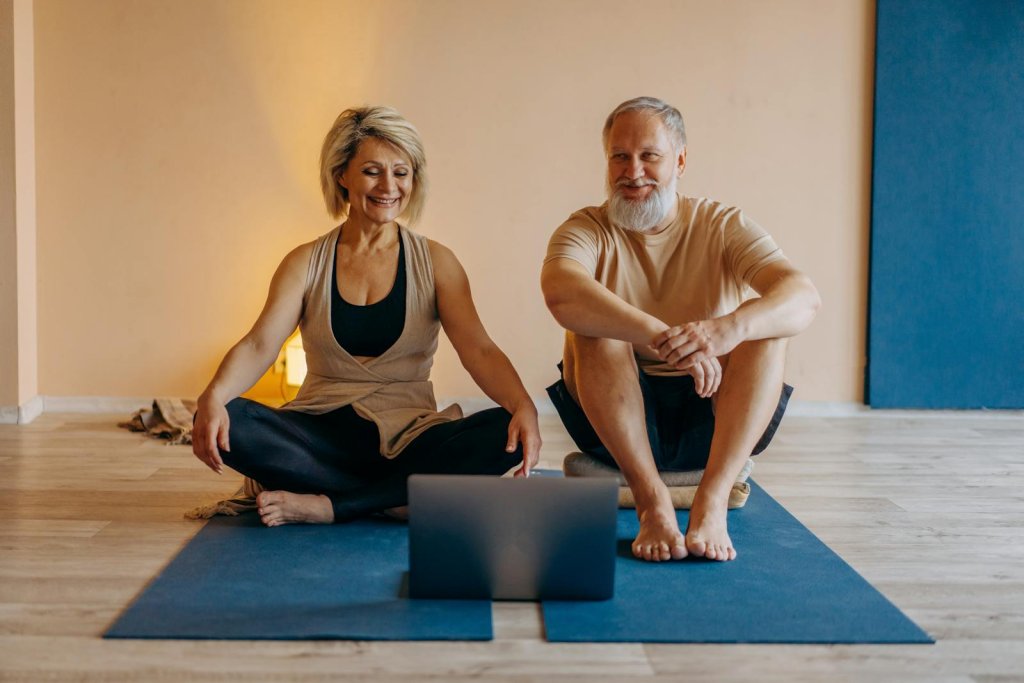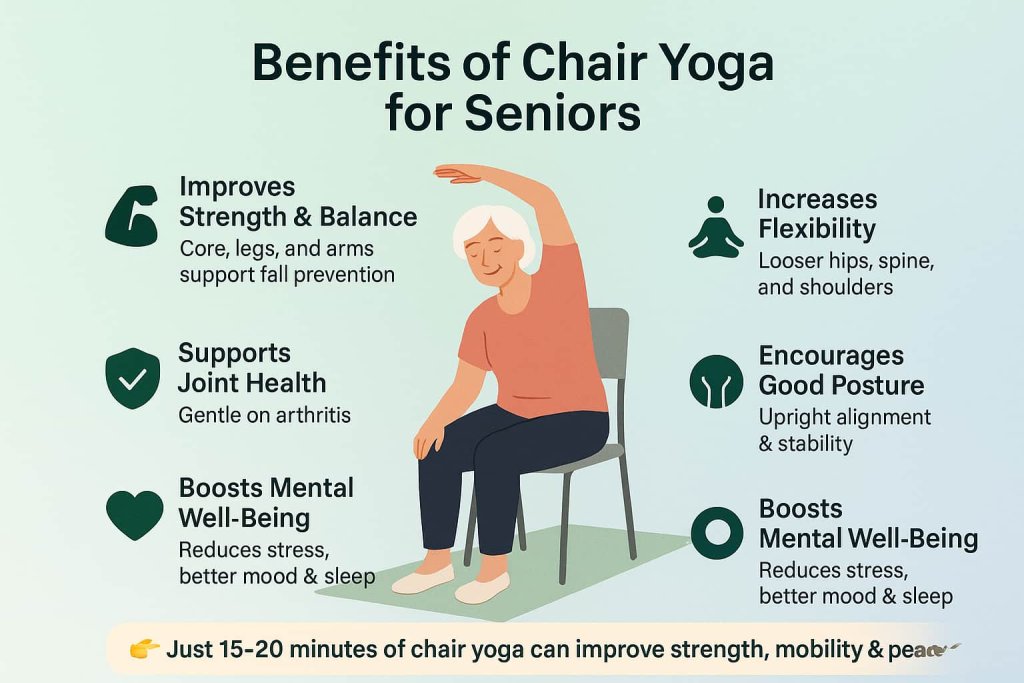Chair yoga is one of the safest and most effective ways for seniors to build strength, improve balance, and reduce stiffness—all while seated or supported by a chair.

This gentle form of yoga is designed for older adults who may struggle with mobility, arthritis, or balance concerns. By using a stable chair for support, seniors can perform stretches and strengthening poses without the risk of falling. Chair yoga improves posture, joint mobility, circulation, and confidence in everyday movement.
In this guide, we’ll cover the best chair yoga poses for seniors, their benefits, safety tips, and expert-backed recommendations.
What Is Chair Yoga for Seniors?
Chair yoga is a low-impact form of yoga where poses are adapted for seated or supported practice. Instead of moving to the floor, seniors stay seated or hold onto a sturdy chair, making it easier to stretch safely.

- Ideal for: older adults with arthritis, limited mobility, or balance issues
- Benefits: builds strength, flexibility, and calmness without strain
- Duration: even 15–20 minutes daily can deliver results
👉 Chair yoga, done twice a week for eight weeks, improved pain and fatigue in seniors with osteoarthritis while also reducing stress levels.
Benefits of Chair Yoga for Seniors
Practicing chair yoga regularly provides both physical and mental health benefits.

- 🦵 Improves Strength & Balance – Builds core, legs, and arms while lowering fall risk.
- 🧘 Increases Flexibility – Keeps joints mobile and reduces stiffness in hips, spine, and shoulders.
- 🛡️ Supports Joint Health – Gentle on arthritic joints while still providing movement.
- 🧍 Encourages Good Posture – Strengthens stabilizer muscles for upright alignment.
- ❤️ Boosts Mental Well-Being – Breathing and mindfulness ease stress, improve mood, and support better sleep.
Best Chair Yoga Poses for Seniors
Chair yoga is one of the safest and most accessible ways for seniors to enjoy the benefits of yoga. By using a sturdy, non-wheeled chair for support, older adults can improve strength, balance, flexibility, and circulation—all without straining their joints. Below are eight beginner-friendly chair yoga poses explained in detail.
1. Seated Mountain Pose
Why it works:
This foundational posture encourages upright posture, strengthens the core, and sets the tone for mindful breathing.
How to do it:
- Sit tall at the edge of a sturdy chair with feet flat on the floor, hip-width apart.
- Lengthen the spine by lifting the crown of your head toward the ceiling.
- Keep shoulders relaxed and arms resting by your sides.
- Engage your abdominal muscles gently.
- Hold for 4–5 deep breaths, inhaling through the nose and exhaling slowly.
Trainer Tip: Imagine a string pulling you upward from the top of your head—this will help prevent slouching.
2. Seated Cat-Cow Stretch
Why it works:
A gentle spinal mobilizer that relieves stiffness in the back and neck, improves flexibility, and aids circulation.
How to do it:
- Sit tall with both hands resting on your knees.
- Inhale (Cow Pose): Arch your back, push your chest forward, and look slightly upward.
- Exhale (Cat Pose): Round your spine, tuck your chin toward the chest, and pull your belly button in.
- Continue flowing between Cat and Cow for 5–10 slow rounds.
Trainer Tip: Move with your breath—don’t rush. This exercise is especially effective for reducing morning stiffness.
3. Seated Twist
Why it works:
Twisting stretches the spine, supports digestion, and eases tension in the lower back.
How to do it:
- Sit upright with feet flat.
- Place your right hand on your left thigh and your left hand on the chair back for support.
- Gently twist your torso to the left, turning your head over the left shoulder if comfortable.
- Hold for 3 breaths, then return to center.
- Switch to the opposite side.
Trainer Tip: Keep the spine tall while twisting. Avoid forcing the movement.
Read Also: 7 Best Yoga Chairs for Seniors: Safe, Comfortable & Supportive Options
4. Seated Pigeon Pose (Hip Opener)
Why it works:
Opens tight hips and glutes, reduces lower-back pressure, and increases flexibility in the pelvic area.
How to do it:
- Sit tall with both feet flat.
- Cross your right ankle over your left knee, creating a figure-4 shape.
- Keep your spine tall.
- For a deeper stretch, lean slightly forward while keeping the back straight.
- Hold for 4–5 breaths, then switch sides.
Trainer Tip: If crossing the ankle over the knee feels too intense, simply cross at the shin instead.
5. Chair Warrior II
Why it works:
Strengthens the legs, arms, and core while enhancing stability and balance.
How to do it:
- Sit sideways on the chair, legs apart—your front leg bent at 90° and your back leg extended straight.
- Stretch both arms outward at shoulder height, palms facing down.
- Gaze softly over your front hand.
- Hold for 5 breaths, then switch sides.
Trainer Tip: Engage your thigh muscles for stability and press firmly into your feet for strength.
6. Chair Reverse Warrior
Why it works:
Lengthens the side body, improves torso mobility, and strengthens the shoulders and arms.
How to do it:
- Begin in Chair Warrior II position.
- Lower your back hand to rest on the leg or chair.
- Raise your front arm overhead, leaning gently backward.
- Hold for 3–4 breaths, then switch sides.
Trainer Tip: Keep your chest lifted and avoid collapsing into your back.
7. Seated Forward Fold
Why it works:
A calming stretch that eases back tension, stretches the hamstrings, and improves blood circulation.
How to do it:
- Sit tall with both feet flat and slightly apart.
- Inhale, then hinge forward at the hips.
- Let your torso drape over your thighs, arms and head relaxing downward.
- Hold for 4–6 breaths, then slowly roll back up.
Trainer Tip: Keep knees slightly bent if your hamstrings feel tight.
8. Heel Raises (with Chair Support)
Why it works:
Strengthens calves and ankles, which are essential for balance and preventing falls.
How to do it:
- Sit or stand while holding the chair for support.
- Keep feet hip-width apart.
- Lift both heels off the ground as high as possible, balancing on the balls of your feet.
- Pause for 1–2 seconds, then lower slowly.
- Repeat 8–10 times.
Trainer Tip: For progression, try doing heel raises without holding the chair once you feel steady.
Safety Tips Before Starting Chair Yoga
- ✅ Use a sturdy, non-wheeled chair.
- ✅ Keep feet flat on the ground; sit tall.
- ✅ Move slowly and avoid sudden jerks.
- ✅ Start with 5–10 reps; increase gradually.
- ✅ Stop immediately if you feel pain or dizziness.
- ✅ Consult your doctor if you have chronic conditions or recent surgery.
How Often Should Seniors Do Chair Yoga?
- Beginner level: 10–15 minutes, 2–3 times per week
- Intermediate level: 20–30 minutes, 3–4 times per week
- Consistency matters: Even short daily sessions improve flexibility, balance, and confidence.
FAQs About Chair Yoga for Seniors
1. Is chair yoga safe for seniors with arthritis?
Yes. Studies show it helps reduce pain and stiffness in osteoarthritis when done gently and consistently.
2. Do I need special equipment for chair yoga?
No. A sturdy chair, comfortable clothing, and a non-slip floor are all you need.
3. Can chair yoga help prevent falls?
Yes. It strengthens ankles, calves, core, and improves balance, lowering fall risk.
4. How is chair yoga different from regular yoga?
Chair yoga adapts traditional poses for seated or supported positions, making it safer for seniors.
5. What if I can’t cross my legs for pigeon pose?
Keep one ankle on the floor and simply lean forward slightly for a gentle stretch.
6. Can chair yoga replace walking or strength training?
It complements other activities but doesn’t replace them. Aim for a mix of chair yoga, walking, and light strength exercises.
7. How soon will I see results?
Many seniors report improved flexibility and reduced stiffness after 4–6 weeks of consistent practice.
Conclusion
Chair yoga is a safe, effective, and empowering way for seniors to improve strength, balance, and flexibility without fear of falling. Even beginners with limited mobility can enjoy its benefits. Start with 2–3 short sessions per week, gradually increasing as you feel stronger.
👉 Ready to try chair yoga? Begin with the simple poses above and enjoy greater confidence, mobility, and peace of mind.
References
- Park J. et al., 2017 — J Am Geriatrics Society (Sit ‘N’ Fit Chair Yoga RCT).
Eight weeks of chair yoga in older adults with lower-extremity osteoarthritis reduced pain interference and fatigue and improved gait speed (pain-interference benefits persisted at 3 months). PubMed Central - Yao C-T. et al., 2023 — Healthcare (Quasi-experimental).
A 12-week chair-yoga program for older women with knee OA significantly improved functional fitness and daily living activity scores. PubMed Central - Tew G. et al., 2024 — Pragmatic RCT in multimorbidity (chair-based yoga).
A 12-week chair-based yoga offer was safe and acceptable (and probably cost-effective) though it did not improve HRQoL versus usual care—useful nuance for expectations. PubMed - Galantino M.L. et al., 2012 — Pilot feasibility in fall-risk seniors (chair-based yoga).
Demonstrated chair-yoga is feasible and safe for very old adults at risk of falls, supporting its use for balance-oriented programming. PubMed Central - NHS Physical Activity Guidelines for Older Adults.
Recommends strength, balance, and flexibility activities on ≥2 days/week (plus 150 min/week moderate activity)—a solid benchmark to frame chair-yoga frequency. nhs.uk
